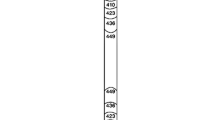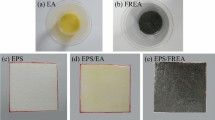Abstract
Intumescent coatings are a great alternative for passive protection of metal substrates against fire, with binder polymer being one of the main components of an intumescent system. The objective of this work was to compare five different resin types (epoxy, acrylic, alkyd, silicone, and silicone–epoxy hybrid) in an intumescent formulation and to study the influence of resin concentration on the fire protection performance of the coating. Results from TGA and MCC analysis of resins and coatings indicated that coatings containing silicone are thermally stable and release smaller amounts of heat. In the fire resistance test, samples containing epoxy and silicone resins had lower temperatures (130–160°C) compared to the other samples. It has also been found that it is possible to decrease resin concentration in formulations containing epoxy and silicone resins up to 25.6% and to maintain or even improve their fire protection capability.
Graphic abstract















Similar content being viewed by others
References
de Sá, SC, de Souza, MM, Peres, RS, Zmozinski, AV, Braga, RM, de Araújo Melo, DM, Ferreira, CA, “Environmentally Friendly Intumescent Coatings Formulated with Vegetable Compounds.” Prog. Org. Coat., 113 47–59 (2017). https://doi.org/10.1016/j.porgcoat.2017.08.007
Fan, F, Xia, Z, Li, Q, Li, Z, “Effects of Inorganic Fillers on the Shear Viscosity and Fire Retardant Performance of Waterborne Intumescent Coatings.” Prog. Org. Coat., 76 844–851 (2013). https://doi.org/10.1016/j.porgcoat.2013.02.002
Yasir, M, Amir, N, Ahmad, F, Ullah, S, Jimenez, M, “Effect of Basalt Fibers Dispersion on Steel Fire Protection Performance of Epoxy-Based Intumescent Coatings.” Prog. Org. Coat., 122 229–238 (2018). https://doi.org/10.1016/j.porgcoat.2018.05.029
Yew, MC, Ramli Sulong, NH, Yew, MK, Amalina, MA, Johan, MR, “Influences of Flame-Retardant Fillers on Fire Protection and Mechanical Properties of Intumescent Coatings.” Prog. Org. Coat., 78 59–66 (2015). https://doi.org/10.1016/j.porgcoat.2014.10.006
Jimenez, M, Duquesne, S, Bourbigot, S, “Intumescent Fire Protective Coating: Toward a Better Understanding of Their Mechanism of Action.” Thermochim. Acta., 449 16–26 (2006). https://doi.org/10.1016/j.tca.2006.07.008
Wang, G, Yang, J, “Influences of Binder on Fire Protection and Anticorrosion Properties of Intumescent Fire Resistive Coating for Steel Structure.” Surf. Coat. Technol., 204 1186–1192 (2010). https://doi.org/10.1016/j.surfcoat.2009.10.040
Li, XL, Zhang, FH, Jian, RK, Ai, YF, Ma, JL, Hui, GJ, Wang, DY, “Influence of Eco-friendly Calcium Gluconate on the Intumescent Flame-Retardant Epoxy Resin: Flame Retardancy, Smoke Suppression and Mechanical Properties.” Compos. B Eng., 176 107200 (2019). https://doi.org/10.1016/j.compositesb.2019.107200
Qian, W, Li, X, Wu, Z, “Effects of Silane Coupling Agent/Organic Bentonite on Tea Saponin Intumescent Flame-Retardant Coatings.” Adv. Mater. Res., 877 1318–1323 (2014). https://doi.org/10.4028/www.scientific.net/AMR.875-877.1318
Chuang, C, Tsai, K, Yang, T, Ko, C, Wang, M, “Applied Clay Science Effects of Adding Organo-Clays for Acrylic-Based Intumescent Coating on Fire-Retardancy of Painted Thin Plywood.” Appl. Clay Sci., 53 709–715 (2011). https://doi.org/10.1016/j.clay.2011.06.009
Gardelle, B, Duquesne, S, Vandereecken, P, Bellayer, S, Bourbigot, S, “Resistance to Fire of Curable Silicone/Expandable Graphite Based Coating: Effect of the Catalyst.” Eur. Polym. J., 49 2031–2041 (2013). https://doi.org/10.1016/j.eurpolymj.2013.04.021
Yang, P, Ren, M, Chen, K, Liang, Y, Lü, Q, Zhang, T, “Synthesis of a Novel Silicon-Containing Epoxy Resin and Its Effect on Flame Retardancy, Thermal, and Mechanical Properties of Thermosetting Resins.” Mater. Today Commun., 19 186–195 (2019). https://doi.org/10.1016/j.mtcomm.2019.01.014
Xu, L, Liu, X, An, Z, Yang, R, “EG-Based Coatings for Flame Retardance of Shape Stabilized Phase Change Materials.” Polym. Degrad. Stab., 161 114–120 (2019). https://doi.org/10.1016/j.polymdegradstab.2019.01.020
Gardelle, B, Duquesne, S, Vandereecken, P, Bellayer, S, Bourbigot, S, “Resistance to Fire of Intumescent Silicone Based Coating: The Role of Organoclay.” Prog. Org. Coat., 76 1633–1641 (2013). https://doi.org/10.1016/j.porgcoat.2013.07.011
Beaugendre, A, Lemesle, C, Bellayer, S, Degoutin, S, Duquesne, S, Casetta, M, Pierlot, C, Jaime, F, Kim, T, Jimenez, M, “Flame Retardant and Weathering Resistant Self-layering Epoxy-Silicone Coatings for Plastics.” Prog. Org. Coat., 136 105269 (2019). https://doi.org/10.1016/j.porgcoat.2019.105269
Standard Test Method for Determining Flammability Characteristics of Plastics and Other Solid Materials Using Microscale Combustion, i (2018) 1–11. https://doi.org/10.1520/d7309-13.responsibility.
Huggett, C, “Estimation of Rate of Heat Release by Means of Oxygen Consumption Measurements.” Fire Mater., 4 (2) 61–65 (1980)
Gardelle, B, Duquesne, S, Rerat, V, Bourbigot, S, “Thermal Degradation and Fire Performance of Intumescent Silicone-Based Coatings.” Polym. Adv. Technol., 24 62–69 (2013). https://doi.org/10.1002/pat.3050
Eduok, U, Faye, O, Szpunar, J, “Recent Developments and Applications of Protective Silicone Coatings: A Review of PDMS Functional Materials.” Prog. Org. Coat., 111 124–163 (2017). https://doi.org/10.1016/j.porgcoat.2017.05.012
Wang, Z, Han, E, Ke, W, “Effect of Acrylic Polymer and Nanocomposite with Nano-SiO2 on Thermal Degradation and Fire Resistance of APP-DPER-MEL Coating.” Polym. Degrad. Stab., 91 1937–1947 (2006). https://doi.org/10.1016/j.polymdegradstab.2006.03.001
Jimenez, M, Duquesne, S, Bourbigot, S, “Kinetic Analysis of the Thermal Degradation of an Epoxy-Based Intumescent Coating.” Polym. Degrad. Stab., 94 404–409 (2009). https://doi.org/10.1016/j.polymdegradstab.2008.11.021
Pereira, CMC, Martins, MSS, Flame Retardancy of Fiber-Reinforced Polymer Composites Based on Nanoclays and Carbon Nanotubes. Elsevier, Amsterdam (2014). https://doi.org/10.1016/b978-0-444-53808-6.00017-2
Sonnier, R, Otazaghine, B, Dumazert, L, Ménard, R, Viretto, A, Dumas, L, Bonnaud, L, Dubois, P, Safronava, N, Walters, R, Lyon, R, “Prediction of Thermosets Flammability Using a Model Based on Group Contributions.” Polymer (Guildf)., 127 203–213 (2017). https://doi.org/10.1016/j.polymer.2017.09.012
Benin, V, Durganala, S, Morgan, AB, “Synthesis and Flame Retardant Testing of New Boronated and Phosphonated Aromatic Compounds.” J. Mater. Chem., 22 1180–1190 (2012). https://doi.org/10.1039/c1jm14682c
Trivedi, MK, Branton, A, Trivedi, D, Nayak, G, Bairwa, K, Jana, S, “Physicochemical and Spectroscopic Characterization of Biofield Treated Triphenyl Phosphate.” Am. J. Appl. Chem., 3 168 (2015). https://doi.org/10.11648/j.ajac.20150305.13
Wang, W, Peng, Y, Zhang, W, Li, J, “Effect of Pentaerythritol on the Properties of Wood- Flour/Polypropylene/Ammonium Polyphosphate Composite System.” BioResources, 10 6917–6927 (2015). https://doi.org/10.15376/biores.10.46917-6927
Zhao, H, Pang, X, Lin, R, “Preparation of Boric Acid Modified Expandable Graphite and Its Influence on Polyethylene Combustion Characteristics.” J. Chil. Chem. Soc., 61 2767–2771 (2016). https://doi.org/10.4067/S0717-97072016000100004
Kandola, BK, Luangtriratana, P, Duquesne, S, Bourbigot, S, “The Effects of Thermophysical Properties and Environmental Conditions on Fire Performance of Intumescent Coatings on Glass Fibre-Reinforced Epoxy Composites.” Materials (Basel), 8 5216–5237 (2015). https://doi.org/10.3390/ma8085216
Wang, Z, Han, E, Ke, W, “Effect of Acrylic Polymer and Nanocomposite with Nano-SiO2 on Thermal Degradation and Fire Resistance of APP–DPER–MEL Coating.” Polym. Degrad. Stabil., 91 (9) 1937–1947 (2006). https://doi.org/10.1016/j.polymdegradstab.2006.03.001
Shi, Y, Wang, G, “Applied Surface Science the Novel Silicon-Containing Epoxy/PEPA Phosphate Flame Retardant for Transparent Intumescent Fire Resistant Coating.” Appl. Surf. Sci., 385 453–463 (2016). https://doi.org/10.1016/j.apsusc.2016.05.107
Gardelle, B, Duquesne, S, Vandereecken, P, Bourbigot, S, “Characterization of the Carbonization Process of Expandable Graphite/Silicone Formulations in a Simulated Fire.” Polym. Degrad. Stab., 98 1052–1063 (2013). https://doi.org/10.1016/j.polymdegradstab.2013.02.001
Ciolacu, D, Ciolacu, F, Popa, VI, “Cellulose Allomorphs: Structure and Characterization.” Cellul. Chem. Technol., 45 13–21 (2011)
de Souza, MM, de Sa, SC, Zmozinski, AV, Peres, RS, Ferreira, CA, “Biomass as the Carbon Source in Intumescent Coatings for Steel Protection Against Fire.” Ind. Eng. Chem. Res., 55 11961–11969 (2016). https://doi.org/10.1021/acs.iecr.6b03537
Ullah, S, Ahmad, F, Yusoff, PSMM, “Effect of Boric Acid and Melamine on the Intumescent Fire-Retardant Coating Composition for the Fire Protection of Structural Steel Substrates.” J. Appl. Polym. Sci., 128 2983–2993 (2013). https://doi.org/10.1002/app.38318
Marciuš, M, Ristić, M, Ivanda, M, Musić, S, “Formation of Iron Oxides by Surface Oxidation of Iron Plate.” Croat. Chem. Acta., 85 117–124 (2012). https://doi.org/10.5562/cca1943
Bannov, AG, Manakhov, A, Shibaev, AA, Ukhina, AV, Polčák, J, Maksimovskii, EA, “Synthesis Dynamics of Graphite Oxide.” Thermochim. Acta., 663 165–175 (2018). https://doi.org/10.1016/j.tca.2018.03.017
Wang, Z, Han, E, Ke, W, “Influence of Expandable Graphite on Fire Resistance and Water Resistance of Flame-Retardant Coatings.” Corros. Sci., 49 2237–2253 (2007). https://doi.org/10.1016/j.corsci.2006.10.024
Beraldo, CHM, Silveira, MRS, Baldissera, AF, Ferreira, CA, “A New Benzoxazine-Based Intumescent Coating for Passive Protection Against Fire.” Prog. Org. Coat., 137 105321 (2019). https://doi.org/10.1016/j.porgcoat.2019.105321
Acknowledgments
The authors thank the Brazilian government agencies CAPES, CNPq, and FAPERGS for funding the research. The authors also thank Evonik for providing Degalan® P675 Acrylic resin, SILIKOPON® EF hybrid epoxy–silicone resin, and DYNASYLAN® AMEO crosslinker; SGS Polímeros for supplying RESYGS SPG 6070 alkyd resin; and, finally, to National de Grafite Company for supplying the expandable graphite.
Author information
Authors and Affiliations
Corresponding author
Additional information
Publisher's Note
Springer Nature remains neutral with regard to jurisdictional claims in published maps and institutional affiliations.
Rights and permissions
About this article
Cite this article
Cardoso, A.P., de Sá, S.C., Beraldo, C.H.M. et al. Intumescent coatings using epoxy, alkyd, acrylic, silicone, and silicone–epoxy hybrid resins for steel fire protection. J Coat Technol Res 17, 1471–1488 (2020). https://doi.org/10.1007/s11998-020-00366-9
Published:
Issue Date:
DOI: https://doi.org/10.1007/s11998-020-00366-9




